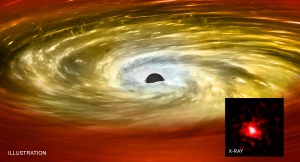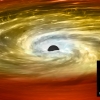The project of a PhD student of the NCBJ Department of Astrophysics qualified for the „Pearls of Science” program
2023.04.04 9:36 - Piotr Spinalski
 The first edition of the competition under the „Pearls of Science” program has been settled. One of the scientists qualified for the program is Krzysztof Lisiecki, MSc, a PhD student at the Astrophysics Department of the National Center for Nuclear Research, conducting research in the project „In search of witnesses to the early Universe – studying the properties of red nuggets”.
The first edition of the competition under the „Pearls of Science” program has been settled. One of the scientists qualified for the program is Krzysztof Lisiecki, MSc, a PhD student at the Astrophysics Department of the National Center for Nuclear Research, conducting research in the project „In search of witnesses to the early Universe – studying the properties of red nuggets”.
The aim of the „Pearls of Science” program organized by the Ministry of Education and Science is to create conditions for the development of extremely talented graduates by enabling them to conduct scientific research under the guidance of a scientific or artistic supervisor. Among the announced results of the first edition of the competition was the project „In search of witnesses of the early Universe – research on the properties of red nuggets”, headed by Krzysztof Lisiecki, PhD student at the NCBJ Department of Astrophysics. Lisiecki’s scientific supervisor is Katarzyna Małek, PhD, prof. NCBJ.
This is how the project manager, Krzysztof Lisiecki, MSc, describes the research:
„In our project, we aim to study the properties of extremely massive and small galaxies, called red nuggets. These galaxies, because they are incapable of forming new stars, are extremely important for modern studies of galaxy formation and evolution, in particular passive galaxies, because we suspect them to be the seeds of the most massive galaxies in the local universe. In addition, we know that some of these objects have never interacted with other galaxies through galaxy mergers, so-called galaxies merger, which has kept it intact for billions of years. The study of these galactic nuclei therefore makes it possible to use systems that have been virtually isolated for most of their existence to recreate conditions in the early universe. Our searches and analyzes so far have resulted in the identification of over 70 objects of this class at redshift z~0.7 (about 6 billion years ago). The red nuggets found were cataloged and published by us. So far, it is the largest catalog of such objects. It allows you to look at the entire population of red galactic nuclei in a more statistical way. We hope that our project, in which we will study the physical properties of the red nuggets we find, will make a significant contribution to the theory of galaxy evolution, and especially to the processes of formation of these unique objects. At the same time, we want to shed new light on the cosmological models and global quantities that characterize our universe. ”
Congratulations on qualifying for the program and we wish you success in your research!

















